European Wound, Ostomy and Continence Supplement

Keeping the skin intact

Renata Batas
S4 The power of knowledge and cooperation





Gabriele Kroboth
S6 Clinical digest


Renata Batas
S10 When physical activity and surgery were thought to be incompatible: the patient’s perspective
Michael P Kelly
S15 Bowel dysfunction after anterior resection for rectal cancer
Jennie Burch, Claire Taylor, Ana Wilson and Christine Norton
S22 A step-by-step decision guide for transanal irrigation: evaluating its usefulness and ef cacy in clinical practice

Anton Emmanuel, Brigitte Collins, Michelle Henderson and Kelly Stackhouse

In association with
S3
Volume 20 | Supplement 9 | November 2022
A brand new nursing podcast episode available to listen now

The latest clinical education on the go








Stoma complications: using patient education and engagement to improve outcomes





ln this episode, Fiona Le Ber, Clinical Nurse Specialist for Bladder and Bowel, describes the cost and impact of stoma complications to patients and the health service and explores how informing and empowering patients can help both avoid their occurrence and quickly manage the problem when it does occur





Listen to the latest clinical expertise and insight www.bjnpodcast.com
Sponsored by: PODCAST
Apple Spotify Soundcloud
Fiona Le Ber Clinical Nurse Specialist for Bladder and Bowel, Queens Nurse. RCN Bladder & Bowel Forum -Chair
European Wound, Ostomy and Continence Supplement
EDITOR Benjamin Wakefield
SUBEDITOR Shabnam Ali
ADVERTISING MANAGER Nicholas Barlow
CIRCULATION DIRECTOR Sally Boettcher
PRODUCTION MANAGER Kyri Apostolou
ASSOCIATE PUBLISHER Sophie Gardner

PUBLISHING DIRECTOR Andrew Iafrati
MANAGING DIRECTOR Anthony Kerr
CHIEF EXECUTIVE OFFICER Ben Allen
Editorial enquiries: benjamin.wakefield@markallengroup.com
Commercial enquiries: nicholas.barlow@markallengroup.com
CONSULTANT EDITOR
Renata Batas, Enterostomal Therapist, Community Health Centre Ljubljana, Slovenia
EDITORIAL BOARD
Ivanka Bencic, Clinical Nurse Specialist, Sisters of Charity Hospital, Zagreb, Croatia
Dušica Biocanin, Head Nurse, First Surgical Clinic, Clinical Centre of Serbia, Belgrade
Concepción Capilla Díaz, Assistant Professor, Faculty of Health Sciences, University of Granada, Spain
Daniele Chaumier, Enterostomal Nurse, Hôpital Tenon, Paris, France
Fiona Davidson, Nurse Manager, Hollister Ireland
Danila Maculotti, Enterostomal Nurse, Poliambulanza Foundation Hospital, Brescia, Italy
Vivien Nagy-Wikstedt, WOC Nurse and Sexual Counsellor, Helsinki University Hospital, Finland
Susan Pridham, Ostomy Nurse Manager (Clinical Lead), Amcare Group, UK
Margarete Anna Wieczorek, Independent Qualified WOC Nurse, Regensburg, Germany
UK PERSONAL SUBSCRIPTION RATES
Quarterly direct debit £25
Annual direct debit £100
Annual credit card £105
2-year credit card £179
3-year credit card £252
Subscribe online: www.magsubscriptions.com
Subscribe by phone: +44 (0) 1722 716997
Institutional pricing: institutions@markallengroup.com
Keeping the skin intact
The three aspects of wound, ostomy and continence nursing all concern care of the skin, as wounds, stomas and continence issues all present circumstances where the skin becomes particularly exposed to possible damage. The skin is the largest human organ, measuring up to 2 m2 and weighing up to 10 kg. The integrity of the skin can be broken due to mechanical trauma, pressure, chemical irritation, infection or other disease. The consequences of skin damage are manifested by redness, swelling, pain, ulcers, necrosis and/or rashes (Batas, 2015). In superficial skin injuries, the skin heals without scarring, while deeper injuries result in scarring (Batas, 2015). Many factors can increase the vulnerability of the skin to damage, such as excessive moisture or dryness on the skin surface (microclimate). The aging process is often associated with an increase in skin fragility, as the skin becomes thinner, more wrinkled and more prone to damage (Stephen-Haynes, 2014).
The skin around a stoma (peristomal skin) is very vulnerable to damage. Severe irritation and eroding around the stoma can quickly occur from contact with stoma effluent, especially that from an ileostomy, which is often strongly alkaline and may still contain the proteolytic enzymes of digestion. Other common causes of peristomal skin damage are repeated traumatic removal of the stoma appliance, causing medical-adhesiverelated skin injury (MARSI), as well as infection or primary abdominal disease. Peristomal skin damage makes it harder to create an adherent seal with the baseplate of the ostomy appliance, leading to greater risk of leaks and thus a vicious cycle. Therefore, maintaining healthy peristomal skin is one of the main aims of good stoma care (Thompson, 2011). Similarly, urinary and faecal incontinence can leave patients susceptible to incontinenceassociated dermatitis (IAD). This is a breakdown in the integrity of the skin caused by contact with urine or faeces (Kayser et al, 2021).
In wound care, optimising healing often requires care for the intact skin around the wound (periwound skin), as well as for the wound itself. This applies to the care of pressure ulcers (PUs), where preventing and efficiently healing chonic wounds requires specialist knowledge, making PUs an indicator of the quality of nursing care (Sillmon et al, 2021).
www.markallengroup.com
Gastrointestinal Nursing is published by MA Healthcare Ltd, St Jude’s Church, Dulwich Road, London SE24 0PB
Tel: +44 (0)20 7738 5454
Website: www.gastrointestinalnursing.co.uk
© MA Healthcare Ltd, 2022. All rights reserved. No part of the Gastrointestinal Nursing may be reproduced, stored in a retrieval system, or transmitted in any form or by any means electronic, mechanical, photocopying, recording, or otherwise without prior written permission of the Publishing Director.
The views expressed do not necessarily represent those of the editor or Gastrointestinal Nursing. Advertisements in the journal do not imply endorsement of the products or services advertised.
ISSN 1479-5248
Printed by Pensord Press Ltd, Blackwood, NP12 2YA
Nurses can rise to this challenge and improve their knowledge by taking part in the Stop Pressure Ulcer Day on 17 November 2022. This series of educational activities on the prevention and treatment of PUs is hosted by the European Pressure Ulcer Advisory Panel (EPUAP) and supported by the European Council of Enterostomal Therapy (ECET). To find out more, visit www.epuap.org/stop-pressure-ulcers. GN
Renata Batas, Consultant Editor
Batas R. Poškodovana koža ob stomi: zakaj in Kako? Zbornik prispevkov z recenzijo [article in Slovenian]. 2015. www. zbornicazveza.si/wpcontent/uploads/2019/10/2015_poskodovana_koza_2015.pdf (accessed 7 November 2022)
Kayser SA, Koloms K, Murray A, Khawar W, Gray M. Incontinence and incontinence-associated dermatitis in acute care: a retrospective analysis of total cost of care and patient outcomes from the premier healthcare database. J Wound Ostomy Continence Nurs. 2021; 48(6):545–552. https://doi.org/10.1097/won.0000000000000818
Sillmon K, Moran C, Shook L, Lawson C, Burfield AH. The use of prophylactic foam dressings for prevention of hospital-acquired pressure injuries: a systematic review. J Wound Ostomy Continence Nurs. 2021; 48(3):211–218. https://doi.org/10.1097/won.0000000000000762
Stephen-Haynes J. The outcomes of barrier protection in periwound skin and stoma care. Br J Nurs. 2014; 23(5):S26–30. https://doi.org/10.12968/bjon.2014.23.Sup5.S26
Thompson H. Matching the skin barrier to the skin type. 2011. www.hollister.com/us/files/case_studies/case_ studies_matching%20the%20skin%20barrier%20to%20the%20skin%20type%20%28mrp_921720%29.pdf (accessed 7 November 2022)
editorial Gastrointestinal Nursing European Wound, Ostomy and Continence Supplement vol 20 sup 9 November 2022 S3
The power of knowledge and cooperation
Gabriele Kroboth celebrates past and future congresses held by the European Council of Enterostomal Therapy
Gabriele Kroboth, President, European Council of Enterostomal Therapy

After a long separation due to the COVID-19 pandemic, 2022 has finally been the year in which members of the European Council of Enterostomal Therapy (ECET) could again meet and exchange ideas in person.
On 25 May 2022, the ECET presented a guest session at the European Wound Management Association (EWMA) congress in Paris. This session focussed on using classification scores for peristomal skin conditions; and it ended with practical case presentations.
On 27–29 October 2022, the ECET joined the World Council of Enterostomal Therapy (WCET) and the International Society of Colon and Rectal Surgeons (ISUCRS) in Istanbul, Turkey (Figures 1 and 2). This 31st ISUCRS biennial congress was the first to be held jointly with nursing societies. The impressive scientific programme included a presentation of the SAC score, developed and evaluated by a scientific team led by Danila Maculotti. The success of the joint congress was the result of excellent cooperation between the ECET board and Ayise Karadag, the ISUCRS convenor.

Building off these successes, the ECET Board has decided to hold a conference of its own on 24–26 September 2023 in Vienna, Austria. The scientific and clinical presentations will be bilingual, in both English and German. The conference will also offer advanced workshops, networking activities and excellent
opportunities to exchange knowledge and experiences with international colleagues. By attending in ECET 2023, nurses can help stay updated and educated on the most recent knowledge and research in
enterostomal therapy. The ECET board encourages readers to submit abstracts to present at this conference. More detailed information can be found on the ECET website at https://ecet-stomacare.eu. GN
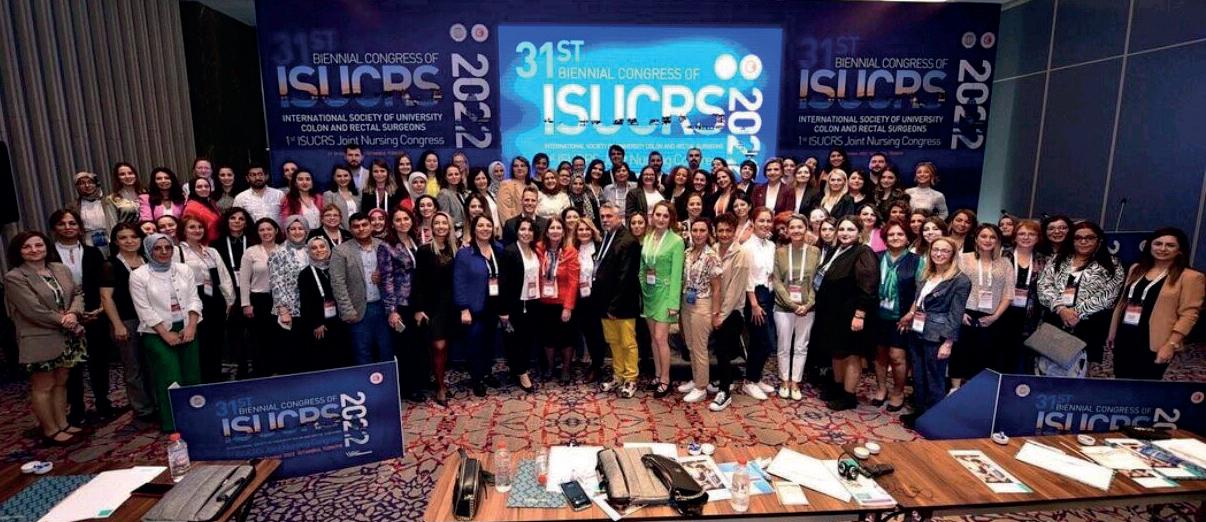
S4 Gastrointestinal Nursing European Wound, Ostomy and Continence Supplement vol 20 sup 9 November 2022 © 2022 MA Healthcare Ltd ECET update
Figure 2. Delegates at the first joint nursing congress in Istanbul, Turkey
ECET
Figure 1. Ayise Karadag (left) and Renata Batas (right) in Istanbul, Turkey
ECET
24-26 SEPTEMBER 2023
EVENTHOTEL PYRAMIDE VIENNA · AUSTRIA
ECET 2023 IS A BI-LINGUAL CONFERENCE WITH HIGH LEVEL SCIENTIFIC AND CLINICAL PRESENTATIONS IN ENGLISH AND GERMAN
The ECET conference offers high level scientific and clinical sessions and workshops, networking activities as well as excellent opportunities to exchange knowledge and experiences with international colleagues.
By participating in ECET 2023, you:
Become updated and educated on the most recent knowledge and research within enterostomal therapy
Get the opportunity to experience and meet with peer researchers and clinicians
Get the chance to attend a variety of high-level sessions, free papers, workshops
Meet suppliers and exchange experiences related to their products
IMPORTANT DATES
Abstract submission opens February 2023
Abstract submission deadline
2 May 2023


Registration opens March 2023
Early registration deadline
2 August 2023

See you at ECET 2023
For more information visit www.ecet2023.org
Clinical digest
A brief overview of recently published articles on wound, ostomy and continence care
Renata Batas, Enterostomal Therapist, Community Health Centre Ljubljana, Slovenia (renata.batas@gmail.com)

Incontinence-associated dermatitis in acute care
Kayser SA,
J Wound Ostomy Continence Nurs. 2021; 48(6):545–552. https://doi.org/10.1097/
WON.0000000000000818
Patients who experience urinary and faecal incontinence are susceptible to the breakdown of skin, such as pressure ulcers (PUs) and incontinence-associated dermatitis (IAD). IAD is characterised by inflammation and/or erosion of the skin from prolonged exposure to urine and/or stool. Studies have found that incontinence prevalence ranges from 18% to 47%, and among incontinent patients the prevalence of IAD ranges from 18% to 46%. Despite high prevalence rates, incontinence and IAD are believed to be underreported due in part to lack of screening, and for IAD specifically because it lacks an optimal International Classification of Diseases, Tenth Revision, Clinical Modification (ICD10-CM) code.
The purpose of this retrospective analysis was to evaluate the prevalence of incontinence and treatment of IAD and associations, with outcomes including total cost of care, length of stay (LoS), 30day readmission, sacral-area PUs present on admission, hospital-acquired pressure injuries and progression of all sacral-area PUs to a higher stage. Given the absence of an optimal IAD ICD-10-CM code, a novel approach to identify incontinent patients treated for IAD was employed. This study used inpatient data from the Premier Healthcare Database (PHD), a hospital administration database. Data were retrieved from the PHD and comprised more than 15million unique adult patient
admissions from 937 hospitals. Patients were 18 years of age or older and admitted to a participating hospital between 1 January 2016 and 31 December 2019. Total cost of care was calculated as the sum of all costs incurred during the index hospital visit and/or subsequent readmissions during a 30-day follow-up period. Given the absence of an IAD ICD10-CM code, patients were categorised by treatment for IAD by selecting patients with a documented incontinence ICD-10CM code and a documented charge for dermatology products used to treat IAD. The t test and χ2 tests determined whether incontinence and treatment for IAD were associated with outcomes.
Results of the sample comprised of over 15 million patients captured from 937 hospitals via the PHD who met inclusion criteria. Among this group, incontinence prevalence was 1.5% for the entire sample, and the prevalence rate for IAD among incontinent patients was 0.7%. Compared with continent patients, incontinent patients had longer LoS (6.4 days versus 4.4 days) and were 1.4 times more likely to be readmitted, 4.7 times more likely to have a sacral PU on admission with a PU (4.7 % vs 1.0%), 5.1 times more likely to have a sacral hospitalacquired PU (0.59% vs 0.12%) and 5.8 times more likely to have a sacral pressure ulcer progress to a severe stage (0.002% vs 0.01%). Compared with incontinent patients without IAD treatment, those with IAD treatment had longer LoS (9.7 days versus 6.4 days) and were 1.3 times more likely to be readmitted and 2 times more likely to have a sacral hospital-acquired pressure ulcer (1.2% vs 0.59%). Total index hospital costs were 1.2 times higher for incontinent patients and 1.3 times
higher for patients with IAD treatment. Despite low prevalence numbers due to underreporting, the results show higher healthcare costs and worse outcomes for incontinent patients and patients with IAD treatment.
Impact of peristomal skin complications
Fellows J, Voegeli D, Håkan-Bloch J, Herschend NO, Størling Z. Multinational survey on living with an ostomy: prevalence and impact of peristomal skin complications. Br J Nurs. 2021; 30(16):S22–S30. https://doi.org/10.12968/bjon.2021.30.16.S22
A survey was conducted to obtain a better understanding of the prevalence of peristomal skin complications (PSCs), including both visual and non-visual complications. The survey sought to explore actions taken by people living with an ostomy due to PSCs and understand how these skin complications physically and emotionally affected patients’ daily life. Alongside this survey, a multinational survey for stoma care nurses was conducted.
The survey for people with an ostomy was distributed to more than 54 000 people with an ostomy from 17 countries including: the USA, China, Japan and the UK. An online survey was sent via email through Coloplast country databases, the Coloplast Online Research Engine (CORE) survey panel (representing UK, USA, France, Germany, and Denmark) or via WeChat in China. The survey questions were translated into the local language. The survey included demographic questions as well as questions related to living with an ostomy. The participants were asked to perform a self-assessment of their peristomal skin condition by recalling the last time they changed their ostomy barrier. A total of 5187 people completed the survey. In the survey population, 56% were male, and 34% had had their ostomy for 0–2 years, 38% for 3–10 years and 28% for more than 10 years. There were 51% with a colostomy, compared with 33% with an ileostomy and 18% with a urostomy. A flat baseplate was used by 51% of the population, 37% used a convex baseplate, 9% a concave baseplate and 3% alternated between different types of baseplate.
© 2022 MA Healthcare Ltd
Koloms K, Murray A, Khawar W, Gray M. Incontinence and incontinence-associated dermatitis in acute care: a retrospective analysis of total cost of care and patient outcomes from the premier healthcare database.
clinical digest S6 Gastrointestinal Nursing European Wound, Ostomy and Continence Supplement vol 20 sup 9 November 2022


































































Recognising clinical excellence in nursing The Awards 2023 Stoma Care Nurse of the Year Do any of your colleagues deserve recognition? Have you excelled in clinical practice? 24th March 2023 Banking Hall | 14 Cornhill | London EC3V 3ND For any enquiries please contact Erin Gallen: Email nurseledconferences@markallengroup.com or call 07964 160 378 ENTER NOW at www.bjnawards.co.uk or scan QR Code Sponsored by Supported by
Self-assessment of the peristomal skin was completed by 4209 of the participants, as the question was not directed at those who irrigated at the time of the survey (n=978). A total of 3706 people reported discoloured skin and/or at least one of the other symptoms, which means that 88% of the participants had some level of PSC. Half of the participants (50%) felt frustrated to some degree when experiencing PSCs, 47% felt stressed out and for 31% it also affected their ability to sleep.
The nurse survey was completed by 328 respondents. Results of the study reported that, among the 328 answers received from the nurse survey, 80% believed that the main reasons for developing PSCs were ostomy-related (type of ostomy, retracted ostomy or a poorly located ostomy). The use of accessories was regarded as equally important for treatment of mild (61%), moderate (66%) and severe (59%) skin complications, whereas the use of a topical steroid, referral to a dermatologist, surgeon or physician were aspects more likely to be necessary for more severe skin complications. For severe cases, more than five contacts were often necessary for solving a PSC.
Overall, the survey was effective in understanding the high incidence of PSCs, their causative factors and their suggested management strategies.
Foam dressings for preventing hospital-acquired pressure ulcers
Sillmon K, Moran C, Shook L, Lawson C, Burfield AH. The use of prophylactic foam dressings for prevention of hospital-acquired pressure injuries: a systematic review. J Wound Ostomy Continence Nurs. 2021; 48(3):211–218. https://doi.org/10.1097/
WON.0000000000000762
Hospitalised patients, especially critically ill patients, are at increased risk for hospitalacquired pressure ulcers (HAPUs) due to multiple factors such as immobility, hemodynamic instability, decreased nutrition and incontinence. These factors negatively affect patient outcomes, increase length of stay and raise hospital costs. One part of an individualised care plan for prevention of HAPU in specific populations is the use of foam dressings.
The purpose of the study was to identify and evaluate the use of prophylactic foam dressings for prevention of HAPUs. A systematic review was conducted in accordance with the Preferred Reporting Items of Systematic Reviews and Metaanalysis Statement (PRISMA). Four researchers independently conducted searches in Health Source, Cochrane of Systematic Reviews, CINAHL, and PubMed. The search identified 380 articles, and 14 were included.
All 14 articles suggested that the use of foam dressings could potentially lower the incident rate of sacral HAPIs. The systematic review reported a statistically significant decrease in the incidence of sacral and heel HAPUs in the intensive care unit (ICU), which was reflected in findings of the two randomised controlled trials. Three of the articles made specific statements about the use of preventative foam dressings in addition to current skin-care practices, such as keeping skin clean and dry, turning patients every 2 hours and ensuring adequate nutrition. Three other articles directly linked the use of preventative foam dressings with monetary savings. One consensus panel provided evidence that the prophylactic use of sacral foam dressings indicated a positive reduction of pressure-ulcer formation.
Limitations across articles include the type of dressing studied, when the dressing was placed, who received the dressing and facility-specific pressure-ulcer prevention practices. While all articles addressed the adult ICU population, some studies applied the preventative dressing to all patients, some only applied the dressing to patients deemed high-risk by facilityspecific grading scales, and the remaining only applied the dressing to those deemed high-risk using the Braden Scale.
Findings suggest that adult patients within an ICU setting may benefit from application of a prophylactic sacral foam dressing to reduce the risk of HAPU. In this study, it is suggested that additional research is needed to determine the benefits of a particular foam configuration, specific eligibility criteria for dressing application, timing
for dressing placement and the relative benefit of prophylactic foam dressings in a multidimensional pressure-ulcer prevention programme. However, latest evidence supports the use of prophylactic foam sacral dressings for patients at risk of HAPUs.
Pressure ulcer risk factors in people with mobility-related disabilities
Sprigle S, McNair D, Sonenblum S. Pressure ulcer risk factors in persons with mobility-related disabilities. adv skin wound care. 2020; 33(3):146–154. https://doi. org/10.1097/01.ASW.0000653152.36482.7d
The objective of the research was to assess the risk of PUs in people with mobility impairments using a large data set to identify demographic, laboratory, haemodynamic and pharmacologic risk factors. The cohort of interest was people with disabilities who have mobility impairments and are diagnostically at risk of PUs. Wheelchair users are 1.8 times more likely to develop a PU.
To define this cohort, diagnoses that qualify patients for skin protection wheelchair cushions were used. Data were obtained from the Cerner Health Facts Data Warehouse. Two cohorts were defined: people with and without a history of PUs. Analysis included descriptive statistics and multivariate logistic regression modeling. Variables retained in the model were identified using LASSO, gradient boosting and Bayesian model averaging.
The resulting cohorts included more than 87 000 persons with a history of PUs and more than 1.1 million persons who did not have a PU. The data revealed seven disability groups with the greatest prevalence of PUs: those with Alzheimer disease, cerebral palsy, hemiplegia, multiple sclerosis, paraplegia/quadriplegia, Parkinson disease and spina bifida. Ulcers in the pelvic region accounted for 82% of PUs. People with disabilities who were male or black had a greater prevalence of PUs. The results indicate that, although people with disabilities can exhibit a wide functional range, they remain at risk of PUs and should be evaluated for proper preventive measures, including support surfaces and wheelchair cushions. GN
© 2022 MA Healthcare Ltd
clinical
S8 Gastrointestinal Nursing European Wound, Ostomy and Continence Supplement vol 20 sup 9 November 2022
digest
The free source of stoma advice you can recommend and pass on to your patients






















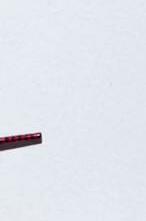





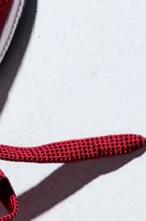







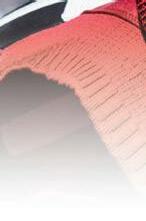





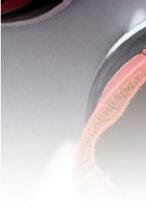













Stoma Tips is the new, free biannual magazine full of practical information and inspiring stories to help ostomates live with comfort and confidence. As an independent magazine, we provide, clear, honest and unbiased advice on ostomy products—written and reviewed by qualified stoma care nurses—to help readers find the stoma routine that works best for them.

We also encourage people to open up about their stoma and break down the stigmas that can keep them silent. Stoma Tips is a place for ostomates to share stories of things that have made them laugh and smile, as well as of how they overcame their more challenging moments. Our aim is to help ostomates of all ages and backgrounds live a life that’s as active, social and independent as before.






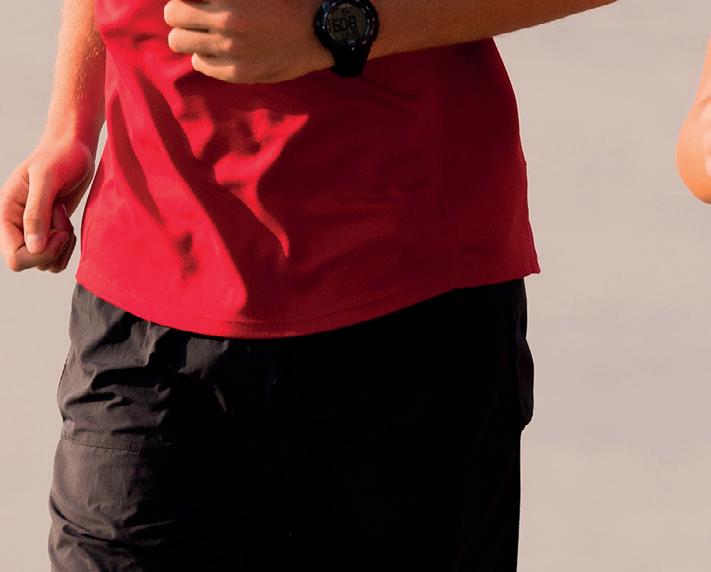
Getting back Running In association with: Tips PRACTICAL ADVICE AND INSPIRATION FOR A CONFIDENT, INDEPENDENT LIFE 001_ST2_Cover.indd 1 29/08/2018 15:39 Order your copy online now or get instant digital access www.stomatips.com In association with: Tips PRACTICAL ADVICE AND INSPIRATION FOR A CONFIDENT, INDEPENDENT LIFE Choosing the right appliances and accessories Stag with a stoma What to wear after stoma surgery Eating more of what you want 001_ST_S18_FM_Cover.indd 04/04/2018 08:38
T
Providing honest and accessible advice to your stoma patients
ips
When physical activity and surgery were thought to be incompatible: the patient’s perspective
Abstract
This paper describes the experience of surgery (panproctocolectomy and ileostomy) and a programme of physical exercise undertaken prior to and after operation. The events took place in 1983, before the contemporary focus on the idea that physical activity might be an adjunct to prehabilitation and rehabilitation in surgery. Some of the implications of the experience are considered. Although there is a growing evidence base about the benefits of physical activity and exercise pre- and postoperatively, this is a relatively recent phenomenon. Carefully supervised exercise may have significant psychological, social and physiological benefits. Exercise may be a very useful aide to pre-operative preparation and postoperative recovery. The paper describes an early example of physical activity in panproctocolectomy and ileostomy formation.
Michael P Kelly, Professor, University of Cambridge mk744@medschl.cam.ac.uk
Key words
Ileostomy
Panproctocolectomy
Patient experience
Physical activity
Prehabilitation
Rehabilitation
This article has been subject to double-blind peer review
Accepted 25 October 2022
Physical activity in both prehabilitation and rehabilitation for surgery has received considerable attention in recent years. Prehabilitation means preparing for treatment and may involve changes to diet and physical activity to affect weight and mental wellbeing. Rehabilitation occurs after treatment or onset of illness and consists of interventions designed to optimise physical, social and psychological functioning. The body of evidence pointing to the value of such interventions has grown in recent years (Wynter-Blyth and Moorthy, 2017; Barberan-Garcia et al, 2018; Bojesen et al, 2022), but this was not always the case.
I had a panproctocolectomy and ileostomy formation in 1983, and I made efforts to build physical activity into my preparation for and recovery from surgery. However, my surgical team then regarded these efforts as, at best, rather eccentric and, at worst, possibly harmful. Attitudes have changed since then, and this paper describes my experiences with surgery and exercise.
By background, I am a public health scientist. I studied economics and sociology as an
undergraduate and continued postgraduate study in sociology and psychiatry. I am now a senior visiting fellow in the Department of Public Health and Primary Care at the University of Cambridge. I am involved in research relating mostly to endof-life care, transport and health, as well as oral health, behaviour change and health inequalities. I retired from the NHS in 2014, and the last post I held was Director of the Centre for Public Health at the National Institute for Health and Clinical Excellence (NICE). Prior to that, I had a long career as an academic and researcher, including research in the 1980s on the impacts and consequences of colorectal surgery (Kelly, 1992). I have worked with nursing and medical colleagues most of my professional life. I still retain an interest in colorectal and surgical matters, and I was delighted to receive an invitation to speak at the
Open access
This is an open access article distributed under the terms of the Creative Commons Attribution Noncommercial License (CC BY-NC 4.0) http://creativecommons.org/licenses/by-nc-nd/4.0/)
case report © Open access S10 Gastrointestinal Nursing European Wound, Ostomy and Continence Supplement vol 20 sup 9 November 2022
Association of Coloproctology Nurses (ACPN) meeting on prehabilitation held in Edinburgh in July 2022. This paper is a summarised version of the talk I gave in July.
Background
The story of my illness began in 1964, when I was 11 years old. I had just started at secondary school, and, in October that year, I had the first attack of uncontrollable diarrhoea. I was playing football when it happened, much to my embarrassment. The symptoms exacerbated over the next few days, with the appearance of blood in the motion, and, within a week or so, I was under the care of the family GP. He kept an eye on things, hoping, as my family did, that this was just an acute infection, but it did not subside. I was not able go to school and, in due course, was referred to the London Hospital (now the Royal London Hospital). I was admitted in December 1964, where, following a range of investigations, I was diagnosed with ulcerative colitis.
I was treated with steroids and salazopyrin, and the symptoms came under control. I was discharged just before Christmas, with advice to take care with what I ate, eliminate milk from my diet and avoid spicy food. As well as oral steroids, I had steroid enemas each evening before going to sleep. I was well enough to go back to school by mid-January and, if rather cautiously at first, tried to resume a normal life. At times, the symptoms were highly intrusive. There were good days and bad days. Sometimes the symptoms were low level, while other times there were episodes of periodic bleeding and exacerbations. Mostly, I would have six or so motions a day, and learned the whereabouts of every toilet on the way to school. I started playing football again, and, in the summer, I played cricket too. Pain and diarrhoea were daily accompaniments to my life, and my early teens were difficult. I did not travel much. Family life was to some extent organised around my illness, and I spent a lot of time with my books.
Teenage years
That was pretty much how life continued through my mid-teens, and my life was arranged around, if not the disease itself, remembering to take the medication (steroids were finally eliminated by the time I was about 13) and, above all, knowing where the toilet was in the case of the need to
suddenly stop what I was doing and go to the loo. Nevertheless, I did almost all the things that teenagers in the 1960s did. I started dating at 15 years old, had girlfriends, continued to play sport and tried my best to appear to be as normal as possible. I went for regular check-ups at the London Hospital, with periodic barium enemas, as well as sigmoidoscopy examinations. By the time I was 14 years old, the disease had settled into a chronic but mostly mild pattern, which continued through my adolescence, and I had learned to live with it.
I studied for my O levels and A Levels and, in due course, headed to university. Of course, student life—the late nights, the drinking and the parties—meant that the disease had to be managed even more carefully. I enjoyed studying and embraced the sporty opportunities that the university provided. I had taken up rowing at the age of 15 and, although not very successful, thought I might do better once I got to university. I joined the university boat club and embarked on the training programme for crew selection. Rowing is a sport that demands a lot of training: four or five times a week in the boat, as well as in the gym doing circuit training and weights. I made a surprising discovery, or at least I thought it so. The harder the training was, the greater the exertion and the better my symptoms became. The fitter I was, the more the symptoms seemed to remit. Conversely, when I stopped training at the end of the season and during vacations, the symptoms seemed to get worse. I did discuss these observations with my consultant, who simply encouraged me to keep on enjoying university life and seemed unmoved by my accounts of the relationship between symptoms and exercise.
Of course, I know enough now about the difference between cause and association— and the dangers of extrapolating from single cases—to understand that this was not the basis for anything very much, medically speaking. Despite the apparent lack of medical interest, I continued with my rowing and training, gained my undergraduate degree and embarked on postgraduate study, starting an academic career in my early 20s. The symptoms were still up and down and occasionally highly intrusive. I got married, and we were expecting our first baby when, on a routine colonoscopy, dysplasia was discovered in my bowel.
case report © Open access Gastrointestinal Nursing European Wound, Ostomy and Continence Supplement vol 20 sup 9 November 2022 S11
The prospect of surgery
By then I knew that, even though I had had a reasonably unproblematic time with the disease, there were potential long-term complications, hence the need for continued monitoring and examination. So, at the age of 29 years, my consultant informed me that there was now a very real chance of the development of cancer. I was referred to a surgeon and, not long afterwards, panproctocolectomy was recommended. I have written elsewhere about the psychological turmoil this caused me, even though I had known that one day this might happen (Kelly, 1985). Despite my many doubts, I consented to surgery. It was elective, so I was able to plan with my doctors when I would be admitted, and I waited until after the birth of my son to have surgery.
Notwithstanding the diagnoses and the new information about changes in my bowel, I felt no different to how I had felt for the previous 10 years. As well as making sure my financial affairs were in order, I decided to redouble my efforts to stay and be as fit as possible. I ran, I went to the gym and, on the weekend before I went into hospital, I ran 14 miles. I felt fit by the morning I set off for the admission.
I was admitted to the hospital a couple of days prior to the date of the operation, and I was placed in a side room for the various tests and discussions with the nursing and medical staff. I decided that this private space was perfect for continuing my exercise routines, so I did press-ups, star jumps and sit-ups, as well as stretching. From time to time, I could see staff peering through the window, and clearly most of them thought this highly amusing and rather weird. Inevitably, the day of the operation duly arrived, and I was sedated. There was no exercise for me from that point on. When I was taken to theatre and the anaesthetist began the process of putting me under, I was explaining to him how fit I was, yet he did not take any notice.
Postoperative experience
After I came round from sedation, the next few days were a complete blur. By the time I was transferred back into the ward and was beginning to make sense of my new body, the stoma, the numbness and the pain, I became very distressed. I was traumatised by the whole thing. Gradually, I did begin to feel
less despondent, and some days after surgery I was visited by the physiotherapist for the usual postoperative physiotherapy.
I am sure I had become a complete bore, because I was explaining to her how I had been a rower, a footballer and a runner, and I was anxious to try to do some of these things again. Running, or perhaps gentle jogging, might be possible. My physiotherapist, not only agreed, but also said that, if I wanted to, after I was discharged, I could come along to the hospital gym, and she would supervise some gentle exercises. I think this was well above and beyond her prescribed duties, but she seemed keen. For me it offered a lifeline, and I readily accepted. Around 2 weeks after discharge and 5 weeks after surgery, I began a programme of exercises; I continued to go three times weekly for 12 weeks.
The results were good, and, after the first session, my posture returned to normal for the first time since the operation; I could stand up straight. Within about 10 days, I began to feel supple and was walking with a spring in my step. Within a fortnight, I was doing quite strenuous gym work, and 7 weeks postoperatively I began jogging gently—only half a mile at first, but I felt elated. As expected, I was not fully fit; I was very fatigued by the surgery, which took months to pass. Getting out of the chair and putting on my kit to go for a run was not easy, physically or mentally, but on most (but not all) days I persisted.
One of the things that helped me was getting in touch with the right people. I contacted Chris Penney, who was the Chair of the Ileostomy Association at the time. He had run a marathon postoperatively and gave me advice and encouragement. The only significant negative consequence of the running, so far as I could tell, was that the stoma sometimes bled, very slightly, around the join to the abdominal wall. I discussed this with my surgeon on a follow-up at the outpatient clinic. He suggested that it was the appliance chafing on the stoma. He wasn’t impressed by my efforts, and his scepticism towards my intentions was palpable. The doctor didn’t say ‘Don’t exercise’, although he was clearly doubtful about any therapeutic benefits, so I continued.
One of the most remarkable things I noticed, after about a month, was how well I felt, and I had an enormous sense of wellbeing. I realised
case report © Open access S12 Gastrointestinal Nursing European Wound, Ostomy and Continence Supplement vol 20 sup 9 November 2022
I had not felt as good for years, possibly since I first had colitis. All those years when I had thought that I was fine, in fact the disease was always present and having a negative, albeit small, effect on my overall health. Colleagues have since suggested to me that it was the endorphins kicking in after the trauma of the surgery. It became clear to me that the physical activity helped to build back my self-confidence. It was as if I was back in control of my own body once again, rather than being controlled by the stoma, the postoperative sequealae and the trauma of the surgery. This helped enormously with my psychological self-confidence. The feeling of being able to do something that I enjoyed and the self-belief that it gave me were profoundly beneficial. Not only was I pleased that I could do quite vigorous physical activity, but most importantly I was pleased that my bag stayed in place. I was content with the idea that, if I ran for a bus, went shopping or stood in a pub, all of which would be less strenuous than my physical activity, I could trust my ostomy appliance.
Longer-term experience
While I was in hospital, I had concluded that I would never be able to row again. The placement of the bag and the stoma seemed to me to be in such an awkward place that it would get in the way of the abdominal compression that rowing demands. I put it out of mind and decided that my rowing career was over, but I did continue to run and go to the gym, and for the next 18 years I kept reasonably fit. I recovered fully from my surgery and have experienced very few postoperative complications. Around 13 years after my operation, and following another career move, I was back living near London, and my son was actively playing rugby when he decided that he wanted to learn to row. We went back to the club I had been a member of before I went to university, to see if he could. I had imagined I would sit on the balcony at the boathouse and sip cold beer, while he was out on the river. He did indeed learn to row and was very keen. Once I started going along with him, I met people with whom I had rowed as a teenager, and it was clear that age, at least, was not a barrier. The following weekend, I packed some kit, joined my son and found myself in a boat for the first time in many years. I was quite
tentative, as I feared that I might damage the stoma, but when I came ashore there were no ill effects. It was with my son that my rowing career began again. I raced for the first time later that summer and have been rowing and competing as a veteran/master’s rower ever since. I do not wear any special stoma fixtures when I row. I use a standard drainable appliance, which I attach using an elastic belt, and I make sure the aperture is larger than my stoma to avoid chafing. When I am not rowing, I wear a drainable appliance that does fit snugly around the stoma, but with no support belt. I have never developed any bulges or herniation around the stoma. Whether this is simply good fortune or the result of exercise, my muscle tone is pretty good, and my weight has not increased much in the years since surgery. I have been able to enjoy a full and active life since surgery, much better than the years with colitis. All those years ago, I was very concerned that my stoma would be the defining characteristic of my life, but it is not. It was certainly a daunting prospect. However, helping patients realise that, while at first it may seem like there is a mountain to climb, there is a wonderful world out there on the other side of the mountain. A stoma is no barrier to participating fully in the world, and, although at first it will not be easy, it gets better, and as time goes by neither you nor others will notice. When I delivered this talk, one of the other speakers was a public health colleague I had known and worked with for more than 30 years. She approached me afterwards telling me she had no idea that I had a stoma or had been through this type of surgery.
Conclusion
These days, physical activity and surgery are not seen as opposed to one another, and the evidence points in the direction of the overall benefits that exercise has before and after surgery. All those years ago, the physiotherapist in the hospital encouraged me and created an opportunity that has been profoundly valuable. I was in pretty good shape physically, apart from the cellular changes taking place in my bowel before surgery, and I was able to build on my physique. My exercise programme and subsequent actions would not be suitable for many people, but that does not mean that exercise cannot be tailored to the needs of
case report © Open access Gastrointestinal Nursing European Wound, Ostomy and Continence Supplement vol 20 sup 9 November 2022 S13
CPD reflective questions

To what extent have patterns concerning prehabilitation and rehabilitation changed in the past 40 years?
While the author clearly saw benefits associated with exercise, do you think that any risks were adequately assessed?
Do you think that the fact that the author was already very active made a difference?
individuals. Rowing is particularly strenuous, and I have wondered over the years whether it would have been a different story if had I tried to row within a few months of my operation. The healing process takes time, and it was well over a decade after the operation when I resumed racing again. There needs to be further studies of the short-term as well as long-term risks and benefits of all kinds of physical activity. Finally, as a scientist, I understand that we clearly cannot generalise from the experience of one person—
in this case me—and we need more data and evidence. Nonetheless, I hope that this story is of some interest and offers a hopeful message to anyone facing up to colorectal surgery. GN
Declaration of interest None
Acknowledgment The authors thanks the Association of Coloproctology Nurses
Barberan-Garcia A, Ubré M, Roca J et al. Personalised prehabilitation in high-risk patients undergoing elective major abdominal surgery: a randomised blinded controlled trial. Ann Surg. 2018; 267(1):50–56. https://doi. org/10.1097/sla.0000000000002293
Bojesen RD, Grube C, Buzquurz F et al. Effect of modifying high-risk factors and prehabilitation on the outcomes of colorectal cancer surgery: controlled before and after study. BJS Open. 2022;6(3):29. https://doi.org/10.1093/ bjsopen/zrac029
Kelly MP. Loss and grief reactions as responses to surgery. J Adv Nurs. 1985; 10(6):517–525. https://doi. org/10.1111/j.1365-2648.1985.tb00542.x
Kelly MP. Colitis. 1st edn. London: Routledge; 1992
Wynter-Blyth V, Moorthy K. Prehabilitation: preparing patients for surgery. BMJ. 2017; 358:j3702. https://doi. org/10.1136/bmj.j3702
case report © Open access S14 Gastrointestinal Nursing European Wound, Ostomy and Continence Supplement vol 20 sup 9 November 2022
AND REVIEWERS To submit a manuscript or register as a reviewer, visit www.editorialmanager.com/gasn Gastrointestinal
Continence Endoscopy GI cancers Hepatology IBD Nutrition Stoma care Liver Nursing Supplement Endoscopy European Wound, Ostomy and Supplement Liver Nursing Supplement
CALL FOR WRITERS
Nursing welcomes submissions of
case
reports,
clinical
reviews
and original research on gastroenterology,
hepatology
and stoma care. All our articles are written, peer-reviewed and read by specialist nurses like you.
If
this is your first time writing or reviewing, the editor and editorial board are able to advise, mentor and support you. To enquire, contact gin@markallengroup.com
Bowel dysfunction after anterior resection for rectal cancer
Abstract
Following bowel surgery for rectal cancer, which involves removal of part of the rectum in a procedure termed an anterior resection, bowel problems are often reported by patients. Collectively, symptoms are referred to as low anterior resection syndrome (LARS). A recently published definition of this phenomenon describes a range of bowel symptoms and the consequences and impacts they have on a person’s lifestyle and quality of life. It is useful to understand what changes occur after an anterior resection and why, to be able to give appropriate information to patients preparing for an anterior resection about what to expect after surgery and to assist with symptom management after surgery.
An anterior resection is the most common operation undertaken for patients with rectal cancer (You et al, 2020). In an anterior resection, part or most of the rectum is removed and the bowel ends are re-joined (anastomosed). The anastomosis can be undertaken using a stapling device that is inserted through the anal canal. For cancers low in the rectum, it is common practice to form a temporary loop ileostomy, which is ideally closed or reversed, in a subsequent operation 3–6 months later. A temporary stoma is formed to protect the healing anastomosis. The gold standard operation for low rectal cancers is to remove the tissues around the rectum (mesorectum), as well as the rectum (Bunni and Moran, 2019), termed a total mesorectal excision (TME). In some cases, very low rectal cancers can be resected, removing tissues between the anal sphincters (intersphincteric resection). Depending on the site, stage and spread of the tumour, some patients will require surgery as well as chemoradiation. Radiotherapy can be used to shrink the cancer prior to the operation (National Institute for Health and Care Excellence (NICE), 2020a). Chemotherapy might also be undertaken, either preoperatively or postoperatively, for example, if there are positive lymph nodes detected in the resected specimen.
All treatment aims to remove the cancer and reduce the risk of the cancer returning.
Bowel dysfunction after rectal cancer surgery
The most reported problem after rectal cancer surgery is bowel dysfunction. Bladder and sexual dysfunction can also occur (Shaw and Ivatury, 2021). Bowel dysfunction after rectal cancer surgery is often referred to as low anterior resection syndrome (LARS). LARS has been defined as ‘disordered bowel function after rectal resection, leading to a detriment in quality of life’ (Bryant et al, 2012), but this definition can over-simplify a complex issue, and a more recent international consensus includes symptoms and consequences of bowel dysfunction, as outlined in Box 1 (Keane et al, 2020).
Symptoms of bowel dysfunction
Increased stool frequency
Increased bowel frequency is compared to the patient’s preoperative bowel frequency (Keane et al, 2020) but is commonly seen as more than four bowel motions per day. Frequency is the most common problem after rectal cancer surgery, reported by almost all patients in one study (Landers et al, 2014). Increased bowel frequency occurs due to nerve damage (Sakr
Jennie Burch, St Mark’s Hospital, Harrow; Claire Taylor, London North West University Healthcare NHS Trust; Ana Wilson, St Mark’s Hospital, Harrow; Christine Norton, Professor, King’s College London, UK jburch1@nhs.net
Key words
Anterior resection
Bowel dysfunction
Consequences
Rectal cancer
Surgery
Symptoms
This article has been subject to double-blind peer review
Accepted 16 November 2021
Gastrointestinal Nursing European Wound, Ostomy and Continence Supplement vol 20 sup 9 November 2022 S15 clinical © 2022 MA Healthcare Ltd
Box 1. Low anterior resection syndrome
Symptoms of bowel dysfunction
• Altered stool consistency
• Emptying difficulties
• Incontinence
• Increased stool frequency
• Repeated painful stools
• Soiling
• Urgency
• Variable, unpredictable bowel function
Consequences of bowel symptoms
• Dissatisfaction with bowels
• Preoccupation with bowel function
• Strategies and compromises
• Toilet dependence
Impact on quality of life
• Mental and emotional wellbeing
• Relationships and intimacy
• Roles, commitments and responsibilities
• Social and daily activities
Source: Keane et al (2020)
et al, 2020), reduced storage capacity in the residual rectum (Chen et al, 2014) and loose stool following radiotherapy. Increased bowel frequency often persists for over a year.
Variable, unpredictable bowel function
Variable and unpredictable bowel function includes nocturnal defecation and difficulties in distinguishing between flatus and faeces. Unpredictable bowels were reported by 86% of patients in one study (Landers et al, 2014). In another study, a quarter of patients reported either nocturnal defecation and/or an inability to distinguish between flatus and faeces (Scheer et al, 2011). Heightened rectal sensitivity can occur after repeated defecation, as well as the anastomosis, giving a false urge to defecate (Nguyen and Chokshi, 2020). Some patients go to the toilet just in case it is faeces, not flatus, in their rectum. Patients report unpredictable bowels as very difficult to manage (Landers et al, 2014).
Emptying difficulties
Emptying difficulties include a feeling of incomplete evacuation after passing a bowel movement (Keane et al, 2020), faecal clustering and fragmentation. Clustering can be described as the need to return to the toilet within an hour
of the previous bowel movement (Nguyen and Chokshi, 2020). Clustering is reported by twothirds of patients after an anterior resection (Bolton et al, 2021). Fragmentation is passing small fragments of faeces. A sensation of incomplete evacuation occurred in about half of patients in one study (Scheer et al, 2011). Stool fragmentation occurs due to nerve damage, which weakens the internal anal sphincter muscle (Christensen et al, 2021). Evacuation difficulties can occur due to poor coordination between the rectum, anus, pelvic floor and anal sphincters because of nerve damage. Evacuation difficulties can also occur due to obstructive symptoms, or an anastomotic stricture caused by scarring following an anastomotic leak or radiotherapy.
Altered stool consistency
Altered stool consistency includes constipation and diarrhoea. In one study, constipation occurred for 4% and diarrhoea for 11% of patients (Emmertsen et al, 2013). It is useful to use the Bristol Stool Form Scale (Lewis and Heaton, 1997) when discussing stool consistency with patients to ensure that the bowel problem is understood.
Urgency
Urgency is the uncontrolled desire to defecate (Yates, 2021) that cannot be delayed for more than 15 minutes (Atherton et al, 2013). In one study, urgency was reported in a third of patients following rectal cancer surgery (Scheer et al, 2011). Urgency improves in the first year for many people but not all. An accentuated gastrocolic reflex resulting in increased colonic motility after eating can cause faecal urgency (Keane et al, 2020). Having radiotherapy as part of the rectal cancer treatment can significantly increase the risk of urgency (Nguyen and Chokshi, 2020).
Incontinence
Anal incontinence is the unplanned passage of faeces or flatus, which includes leakage at night, faecal incontinence and flatus incontinence. Faecal incontinence is common after rectal cancer surgery but for many people improves over time (Pilkington et al, 2021). Faecal incontinence occurs in a third of patients 2 years after an anterior resection in one study (Scheer et al, 2011). In another study, nocturnal leakage
S16 Gastrointestinal Nursing European Wound, Ostomy and Continence Supplement vol 20 sup 9 November 2022 clinical © 2022 MA Healthcare Ltd
occurs for a quarter of patients a year after an intersphincteric resection (Barisic et al, 2011). Whereas flatus incontinence was reported by two-thirds of patients in another study (Bolton et al, 2021), occurring in half on at least a weekly basis in a further study (Battersby et al, 2016). Faecal incontinence can occur for many reasons, including anal sphincter damage (Dilke et al, 2021), chemotherapy, radiotherapy (Nguyen and Chokshi, 2020), rectal resection (Ihnát et al, 2018) and nerve damage.
Repeated painful stools
Repeated painful stools describes pain associated with the urge to defecate, as well as pain when passing and after passing a bowel motion (Keane et al, 2020a). In one study, around one-in-five participants reported pain when they had the urge to pass a motion (Chen et al, 2014), and, in another study, half of the participants reported general anorectal pain (Landers et al, 2014). Additionally, patients might report being able to feel their stapled anastomosis initially after surgery. Rectal pain may be due to problems such as tension in the pelvic diaphragm or difficulty relaxing the anal sphincters during defecation. Other pathology that may result in anal pain, such as anal fissure or haemorrhoids, also needs to be excluded when investigating pain after rectal cancer surgery.
Soiling
Soiling is the involuntary passage of a faecal smear onto underwear or pads after defecation. Soiling can occur due to damage to the internal anal sphincter.
Consequences and impact on quality of life
Reassuringly, although bowel symptoms are necessarily problematic, in one study, just over half of participants stated that their bowel symptoms did not have major life consequences for them (Landers et al, 2014). Nonetheless, in that study, half of participants did not feel comfortable if they were not near a toilet or did know where toilets were located. In another study, about one-in-five participants made compromises to their lifestyle to help them to live with issues such as faecal incontinence, such as wearing pads and taking antidiarrhoeal medication (Lin et al, 2015).
Unpredictable bowels make it difficult to plan activities. Qualitative studies have reported participants needing to make changes to their daily routines. Patients may need to take medication, with one study participant reporting: ‘When I go outside, I usually take some medicines’ (Tsui and Huang, 2021). Some patients plan activities around their bowels when it is ‘safe’ to go out (Lu et al, 2017). Work schedules and travel to work may need to be adjusted, as outlined by a study participant who ‘avoids breakfast to allow for “safe travel to work”’ (Lander et al, 2012). Bowel dysfunction can change relationships with friends, colleagues and partners and cause patients to choose not to go out, such as a study participant who said ‘I refuse to meet friends’ (Tsui and Huang, 2021). Patients can feel disconnected from their family and friends, such as a study participant who stated that ‘You can be alone when you’re together’ (van der Heijden et al, 2018).
In one study, bowel symptoms resulted in feelings such as anxiety and depression in about one-in-five patients after rectal cancer surgery (Powell-Chandler et al, 2020). These low moods might be because of the restrictions created by bowel symptoms, which for one person meant that ‘You can’t do things’ (Wright et al, 2006). Patients may also feel embarrassed, vulnerable and emotionally isolated as a result of their bowel dysfunction (Taylor and Bradshaw, 2013).
Risk factors for bowel dysfunction
There are several risk factors for bowel dysfunction after an anterior resection. Risks relate to patient characteristics and cancer treatment. The risk factors for subsequent bowel dysfunction related to the cancer treatment include pelvic radiotherapy (Battersby et al, 2018), an anastomosis less than 5 cm from the anus (Ye et al, 2022), transanal stapling of the anastomosis (Dilke et al, 2021) and patients undergoing an intersphincteric resection (Denost et al, 2020). Opinion varies about the presence of a temporary ileostomy as an increased risk factor for subsequent bowel dysfunction. Battersby et al (2018) suggested that the formation of a stoma increases the risk of bowel dysfunction. Whereas Vogel et al (2021) considered that it is only a risk if there is a delay in closing the ileostomy. Patient-related risk factors include pre-existing conditions, such as irritable bowel
Gastrointestinal Nursing European Wound, Ostomy and Continence Supplement vol 20 sup 9 November 2022 S17 clinical © 2022 MA Healthcare Ltd
syndrome (Christensen et al, 2021) and poor anal sphincter function (Emmertsen, 2019). Four factors with a significantly increased risk (p<0.01) of major bowel dysfunction are radiotherapy, a low rectal cancer, a temporary ileostomy and an anastomotic leak (Sun et al, 2021).
How cancer treatment changes bowel function
Rectal cancer treatment can result in changes in bowel function. Altered bowel function is often multifactorial, with causes relating to rectal surgery, radiotherapy and chemotherapy. Incontinence may result from pelvic-floor and anal-sphincter muscles being damaged during surgery, often weakened due to disuse when the ileostomy is in situ (Vogel et al, 2021). Nerves can be damaged following surgery, pelvic radiotherapy and chemotherapy. Changes in the gut flora causing diarrhoea can occur when the temporary ileostomy is reversed (Emmertsen and Laurberg, 2016) or following radiotherapy and/ or chemotherapy, which can change the faecal consistency after the stoma is reversed. Increased bowel frequency can occur due to the rectal resection reducing faecal storage capacity (Sakr et al, 2020), which means that it is less able to store faeces and can result in more trips to the toilet. Bowel frequency also occurs due to a reduced ability of the rectal walls to distend following an anastomotic leak or fibrosis following radiotherapy (Christensen et al, 2021).
Improvements in bowel function
Many patients (85%) experience an alteration in their bowel function after an anterior resection (Pape et al, 2021). Most people see some improvement in the first 3 months. Improvement in bowel function usually occurs in the first 2 years, with a small (2.4%) yearly reduction in prevalence of severe bowel symptoms occurring for 15 years after surgery (Dilke et al, 2021). Bowel symptoms vary both between patients and for the same
CPD reflective questions
What bowel changes can occur for patients after rectal cancer treatment?
Reflecting upon your patients following rectal cancer surgery, why do bowel changes tend to occur?
What advice can you give to a patient with bowel dysfunction to help them adjust more quickly?
patient, with patients having an average of four bowel symptoms (Landers et al, 2014). It is worth considering that about half of patients will still have major bowel problems 18 months after their operation (Al-Rashid et al, 2022) and may need specialist assistance to enable a good quality of life, such as from a pelvic-floor therapist.
Clinical implications
It is important to have discussions about the risks and benefits of rectal cancer treatment, to ensure a good understanding of bowel function, as well as to enable realistic expectations. Surgery, radiotherapy and chemotherapy can negatively affect bowel function. Bowel dysfunction is more likely to occur if a person has the following risk factors: a low rectal cancer, radiotherapy, an anastomotic leak and/or the formation of a temporary ileostomy. However, people with preexisting bowel problems may find that rectal cancer treatment will worsen these problems. This is potentially important, as there is an increase in younger people being diagnosed with rectal cancer who may also have irritable bowel syndrome and who may not be considered as at risk of bowel dysfunction in the postoperative period. In the postoperative period, it is important to screen for bowel dysfunction (Sakr et al, 2020) using tools such as the LARS score (Emmertsen and Laurberg, 2012). Following assessment, it may be necessary to make appropriate referrals to enable symptom intervention, such as to continence nurses. It is also necessary to reassure patients that there are many potential treatment options available to assist with bowel function, ranging from changing diet to biofeedback, transanal irrigation and surgical options. However, there is limited evidence to support the use of interventions for bowel symptoms. Due to lack of evidence, a recent document from NICE (2020b) was unable to recommend a treatment pathway for people with LARS, and thus more work is needed on this topic.
Conclusion
Bowel dysfunction is seen commonly after rectal cancer surgery. There are many possible causes of bowel dysfunction that relate to the location and treatment of the cancer, as well as individual factors. Resection of the rectum removes the storage chamber that holds the formed stool. Direct damage to internal structures such as the
S18 Gastrointestinal Nursing European Wound, Ostomy and Continence Supplement vol 20 sup 9 November 2022 clinical © 2022 MA Healthcare Ltd
nerves and anal sphincters can affect the process of defecation and continence. This manifests in symptoms such as having to go to the toilet in a rush or more often than before. These bowel symptoms can have a negative effect on quality of life, and patients often report altering their lifestyle to adjust better to cope with their bowel symptoms. It is important to remember that there are potenital additional treatments available to assist patients with bowel dysfunction. GN
Declaration of interest
None
Al-Rashid F, Robitaille S, Liberman AS et al. Trajectory of change of low anterior resection syndrome over time after restorative proctectomy for rectal adenocarcinoma. Tech Coloproctol. 2022; 26(3):195–203. https://doi. org/10.1007/s10151-021-02561-1
Atherton PJ, Halyard MY, Sloan JA et al. Assessment of patient-reported measures of bowel function before and after pelvic radiotherapy: an ancillary study of the North Central Cancer Treatment Group study N00CA. Support Care Cancer. 2013; 21(4):1193–1199. https://doi. org/10.1007/s00520-012-1648-8
Barisic G, Markovic V, Popovic M et al. Function after intersphincteric resection for low rectal cancer and its influence on quality of life. Colorectal Dis. 2011; 13(6):638–643. https://doi.org/10.1111/j.14631318.2010.02244.x
Battersby NJ, Juul T, Christensen P et al. United Kingdom low anterior resection syndrome study group. predicting the risk of bowel-related quality-of-life impairment after restorative resection for rectal cancer: a multicenter crosssectional study. Dis Colon Rectum. 2016; 59(4):270–80. https://doi.org/10.1097/DCR.0000000000000552
Bolton WS, Chapman SJ, Corrigan N et al. The incidence of low anterior resection syndrome as assessed in an international randomized controlled trial (MRC/NIHR ROLARR). Ann Surg. 2021; 274(6):e1223–e1229. https:// doi.org/10.1097/SLA.0000000000003806
Bryant CLC, Lunniss PJ, Knowles CH, Thaha MA, Chan CLH. Anterior resection syndrome. Lancet. 2012; 13(9):e403–e408. https://doi.org/10.1016/S1470-2045(12)70236-X
Bunni J, Moran BJ. Surgery for rectal cancer. In Clark S (ed). Colorectal surgery. 6th edn. London: Elsevier; 2019:63–74
Chen TYT, Wiltink LM, Nout RA et al. Bowel function 14 years after preoperative short-course radiotherapy and total mesorectal excision for rectal cancer: report of a multicenter randomized trial. Clin Colorectal Cancer. 2014; 14(2):106–114. https://doi.org/10.1016/j.clcc.2014.12.007
Christensen P, IM Baeten C, Espín-Basany E et al. MANUEL Project Working Group. Management guidelines for low anterior resection syndrome – the MANUEL project. Colorectal Dis. 2021; 23(2):461–475. https://doi. org/10.1111/codi.15517
Denost Q, Moreau JB, Vendrely V et al. Intersphincteric resection for low rectal cancer: the risk is functional rather than oncological. A 25‐year experience from Bordeaux. Colorectal Dis. 2020; 22(11):1603–1613. https://doi. org/10.1111/codi.15258
Dilke SM, Hadjittofi C, Than M, Tozer PJ, Stearns A. Anterior resection syndrome and quality of life with long-term follow-up after rectal cancer resection. Dis Colon Rectum. 2022(epub ahead of print); 65(10):1251–1263. https://doi. org/10.1097/DCR.0000000000002107
Emmertsen KJ, Laurberg S. Low anterior resection syndrome score: development and validation of a symptom-based scoring system for bowel dysfunction after low anterior resection for rectal cancer. Ann Surg. 2012; 255(5):922–928. https://doi.org/10.1097/SLA.0b013e31824f1c21
Emmertsen KJ, Laurberg S, Jess P et al, Rectal cancer function study group. Impact of bowel dysfunction on quality of life after sphincter-preserving resection for rectal cancer. Br J Surg. 2013; 100(10):1377–1387. https://doi.org/10.1002/ bjs.9223
Emmertsen KJ, Laurberg S. Identifying and treating patients with pelvic organ dysfunction after treatment for pelvic cancer. Dis Colon Rectum. 2016; 59(1):83–85. https://doi. org/10.1097/DCR.0000000000000496
Emmertsen K. Low anterior resection syndrome (LARS). 2019. www.escp.eu.com/news/focus-on/faecalincontinence/1819-low-anterior-resection-syndrome (accessed 3 October 2021)
Ihnát P, Vávra P, Prokop J, Pelikán A, Ihnát Rudinská L, Penka I. Functional outcome of low rectal resection evaluated by anorectal manometry. ANZ J Surg. 2018; 88(6):E512–E516. https://doi.org/10.1111/ans.14207
Keane C, Wells C, O’Grady G, Bissett IP. Defining low anterior resection syndrome: a systematic review of the literature. Colorectal Dis. 2017; 19(8):713–722. https://doi. org/10.1111/codi.13767
Keane C, Fearnhead NS, Bordeianou LG et al, LARS international collaborative group. International consensus definition of low anterior resection syndrome. Dis Colon Rectum. 2020; 63(3):274–284. https://doi.org/10.1097/ DCR.0000000000001583
Landers M, McCarthy G, Livingstone V, Savage E. Patients’ bowel symptom experiences and self-care strategies following sphincter-saving surgery for rectal cancer. J Clin Nurs. 2014; 23(15-16):2343–2354. https://doi. org/10.1111/jocn.12516
Lewis SJ, Heaton KW. Stool form scale as a useful guide to intestinal transit time. Scand J Gastroenterol. 1997; 32(9):920–4. https://doi. org/10.3109/00365529709011203
Lin YH, Chen HP, Liu KW. Fecal incontinence and quality of life in adults with rectal cancer after lower anterior resection. J Wound Ostomy Continence Nurs. 2015; 42(4):395–400. https://doi.org/10.1097/WON.0000000000000135
Lu LC, Huang XY, Chen CC. The lived experiences of patients with post-operative rectal cancer who suffer from altered bowel function: a phenomenological study. Eur J Oncol Nurs. 2017; 31:69–76. https://doi.org/10.1016/j. ejon.2017.10.004
National Institute for Health and Care Excellence. Colorectal cancer. 2020a. www.nice.org.uk/guidance/NG151. (accessed 9 October 2022)
National Institute for Health and Care Excellence. Colorectal cancer (update): optimal management of low anterior resection syndrome. 2020b. www.nice.org.uk/guidance/ ng151/evidence/e2-optimal-management-of-low-anteriorresection-syndrome-pdf-253058083677 (accessed 9 October 2022)
Nguyen TH, Chokshi RV. Low anterior resection syndrome. Curr Gastroenterol Rep. 2020; 22(10):48. https://doi. org/10.1007/s11894-020-00785-z
Pape E, Pattyn P, Van Hecke A et al. Impact of low anterior resection syndrome (LARS) on the quality of life and treatment options of LARS – a cross sectional study. Eur J Oncol Nurs. 2021; 50:101878. https://doi.org/10.1016/j. ejon.2020.101878
Gastrointestinal Nursing European Wound, Ostomy and Continence Supplement vol 20 sup 9 November 2022 S19 clinical © 2022 MA Healthcare Ltd
Pilkington SA, Bhome R, Gilbert S et al. Sequential assessment of bowel function and anorectal physiology after anterior resection for cancer: a prospective cohort study. Colorectal Dis. 2021; 23(9):2436–2446. https://doi.org/10.1111/ codi.15754
Powell-Chandler A, Boyce K, James O, Scourfield L, Torkington J, Bisson J, Cornish JA, PISA trial management group. Psychological sequelae of colonic resections. Colorectal Dis. 2020; 22(8):945–951. https://doi.org/10.1111/codi.14986
Sakr A, Sauri F, Alessa M et al. Assessment and management of low anterior resection syndrome after sphincter preserving surgery for rectal cancer. Chin Med J (Engl). 2020; 133(15):1824–1833. https://doi.org/10.1097/ CM9.0000000000000852
Scheer AS, Boushey RP, Liang S, Doucette S, O’Connor AM, Moher D. The long-term gastrointestinal functional outcomes following curative anterior resection in adults with rectal cancer: a systematic review and meta-analysis. Dis Colon Rectum. 2011; 54(12):1589–1597. https://doi. org/10.1097/DCR.0b013e3182214f11
Shaw RD, Ivatury SJ. Late and long-term symptom management in colorectal cancer survivorship. Dis Colon Rectum. 2021; 64(12):1447–1450. https://doi.org/10.1097/ DCR.0000000000002262
Sun R, Dai Z, Zhang Y, Lu J, Zhang Y, Xiao Y. The incidence and risk factors of low anterior resection syndrome (LARS) after sphincter-preserving surgery of rectal cancer: a systematic review and meta-analysis. Support Care Cancer. 2021; 29(12):7249–7258. https://doi.org/10.1007/s00520-02106326-2
Taylor C, Bradshaw E. Tied to the toilet. J Wound Ostomy Continence Nurs. 2013; 40(4):415–421. https://doi. org/10.1097/WON.0b013e318296b5a4
Tsui H, Huang XY. Experiences of losing bowel control after lower anterior resection with sphincter saving surgery for rectal cancer: a qualitative study. Cancer Nurs. 2021 (epub ahead of print). https://doi.org/10.1097/ NCC.0000000000001036
van der Heijden JAG, Thomas G, Caers F, van Dijk WA, Slooter GD, Maaskant-Braat AJG. What you should know about the low anterior resection syndrome – Clinical recommendations from a patient perspective. Eur J Surg Oncol. 2018; 44(9):1331–1337. https://doi.org/10.1016/j. ejso.2018.05.010
Vogel I, Reeves N, Tanis PJ, Bemelman WA, Torkington J, Hompes R, Cornish JA. Impact of a defunctioning ileostomy and time to stoma closure on bowel function after low anterior resection for rectal cancer: a systematic review and meta-analysis. Tech Coloproctol. 2021; 25(7):751–760. https://doi.org/10.1007/s10151-021-02436-5
Wright FC, Crooks D, Fitch M, Hollenberg E, Maier BA, Last LD, Greco E et al. Qualitative assessment of patient experiences related to extended pelvic resection for rectal cancer. J Surg Oncol. 2006; 93(2):92–99. https://doi.org/10.1002/jso.20382
Yates A. Transanal irrigation to treat bowel dysfunction: an update on practice. Gastrointest Nurs. 2021; 19 Sup9:S20–S28. https://doi.org/10.12968/gasn.2021.19.Sup9.S20
Ye L, Huang M, Huang Y, Yu K, Wang X. Risk factors of postoperative low anterior resection syndrome for colorectal cancer: A meta-analysis. Asian J Surg. 2022; 45(1):39–50. https://doi.org/10.1016/j.asjsur.2021.05.016
You YN, Hardiman KM, Bafford A et al. The American Society of colon and Rectal Surgeons clinical practice guidelines for the management of rectal cancer. Dis Colon Rectum. 2020; 63(9):1191–1222. https://doi.org/10.1097/ DCR.0000000000001762
S20 Gastrointestinal Nursing European Wound, Ostomy and Continence Supplement vol 20 sup 9 November 2022 clinical © 2022 MA Healthcare Ltd
ips the free ma gazine for ostomates practical advice and inspiration for a comfortabl e, independent life read and order online at www.stomatips.com
T








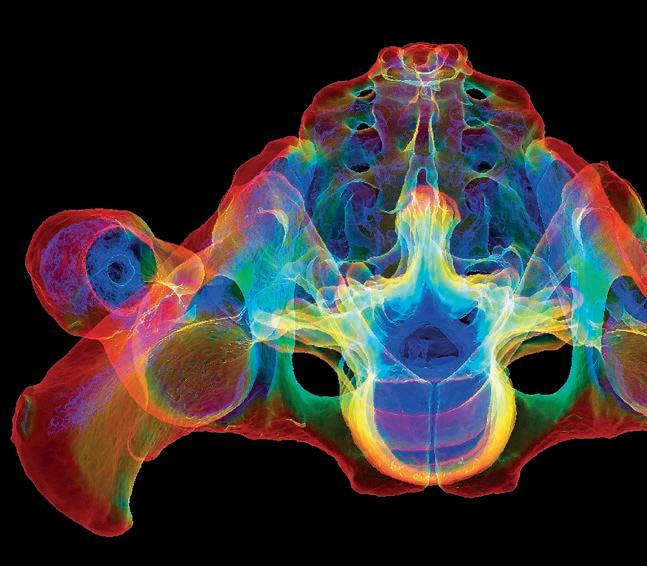



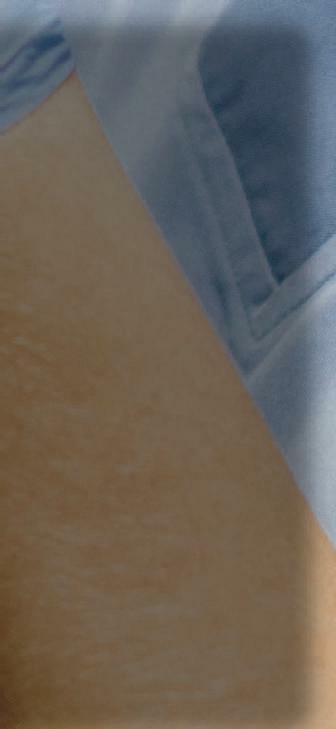




























The key to unlocking your full potential Subscribe from £13.75 per month www.magsubscriptions.com/bjn 0800 137 201 (UK only) | +44 (0)1722 716997 (Overseas) Includes 30-day money back guarantee. Monthly subscriptions start from £13.75. Annual subscriptions start from £147.00. Premium subscriptions include access to CPD Launchpad. P&P included for UK-based subscribers only. British Journal of Nursing (BJN) is an essential resource for any practising nurse. Every fortnight it shares the latest best practice across a range of clinical areas, alongside professional guidance central to your role. Subscriptions include complete access to our online archive. With more than 9,000 articles dating back to 1992, it is the UK’s leading source of peer-reviewed nursing information. Carrying out systematic literature reviews: an introduction Palliative care after the Liverpool Care Pathway: a study of staff experiences FOCUS Volume 28 Number 15 Continence THE ONLY FORTNIGHTLY JOURNAL FOR CLINICAL NURSES ORAL CARE ◆ PERSONAL PROTECTIVE EQUIPMENT ◆ NOWWITHEVENMORE CLINICAL CONTENT Volume 28 Number 15 Pages 957–1040 ◆ 8 August 2019–11 September 2019 British Journal of Nursing BJON_2019_28_15_957_Cover.indd 1 31/07/2019 12:06 FOCUS SUPPLEMENT Non-medical practitioner roles in the UK: who. where and what factors influence their development? Higher degrees in nursing: traditional research PhD or professional doctorate? IV Therapy Respiratory care Volume 28 Number 14 THE ONLY FORTNIGHTLY JOURNAL FOR CLINICAL NURSES REFLUX ◆ PEAK FLOW ◆ COMPRESSION NOWWITHEVENMORE CLINICAL CONTENT Volume 28 Number 14 Pages 901–956 25 July 2019–7 August 2019 British Journal Nursing Providing an evidence base for clinical practice and a platform for professional development
A step-by-step decision guide for transanal irrigation: evaluating its usefulness and efficacy in clinical practice
Abstract
Transanal irrigation (TAI) systems for bowel dysfunction are increasingly used as a management option for patients with constipation or faecal incontinence who fail to adequately improve their symptoms with conservative bowel management. A wide range of products available can make deciding which system to use challenging and overwhelming. The growing use and variety of TAI systems has created the need for guidelines to help clinicians initiating TAI choose the right device for the right patient for the right reasons. Therefore, an evidence-informed decision guide was developed by an expert consensus group to help clinicians make decisions tailored for each individual patient, based on theory and practicalities and promoting safe practice. Feedback from evaluations suggests that this guide is allowing clinicians to access a useful summary to assist consultations and practical discussions.
Anton Emmanuel, Consultant Gastroenterologist, University College London Hospitals NHS Foundation Trust; Brigitte Collins, * Global Clinical Education Manager, MacGregor Healthcare, East Lothian, Scotland; Michelle Henderson, Clinical Education Manager, MacGregor Healthcare, East Lothian, Scotland; Kelly Stackhouse, Lead Nurse, Sandwell and West Birmingham NHS Trust
*brigitte@qufora.co.uk
Transanal irrigation (TAI) is an established treatment for managing both functional and neurogenic bowel dysfunction. With an ever-increasing range of products, choosing the right equipment for the right patient may feel overwhelming. In acknowledgement of this, a working party of experts has developed a decision guide and an assessment proforma (MacGregor Healthcare, 2020a;b). These documents are intended as step-by-step guides for healthcare professionals (HCPs) to aid with TAI assessment, initiation (equipment choice and regimen teaching) and follow-up. Their development has been described in a previous article by Emmanuel et al (2019). This follow-up article discusses the evaluation of the decision guide and assessment proforma in clinical practice.
The decision guide was launched with a webinar in October 2020. This was watched by over 100 HCPs, working in a variety of roles. Feedback from this event suggested that the guide had been warmly received. Following this webinar, a first evaluation of its usefulness in practice was undertaken.
Of 38 bowel dysfunction specialists invited to look at both the layout and functionality of the decision guide and assessment proforma, 27 responded (giving a 71% response rate). Data were analysed, and suggested modifications, mostly related to the layout, were reviewed and agreed by the expert working party.
Aim
A second evaluation, was carried out, aiming to asses the layout and usefulness of the decision guide and assessment proforma.
Method
This evaluation took place over 3 months (January–March 2021). This period coincided with the third national COVID-19 lockdown in England. Many bowel services remained closed or had reduced capacity during this time. Consequently, there were fewer bowel specialists available to use and evaluate this modified version. However, 19 HCP champions were invited to take part. They all had experience (although of varying levels) in initiating and teaching patients how to
S22 Gastrointestinal Nursing European Wound, Ostomy and Continence Supplement vol 20 sup 9 November 2022 research © 2022 MA Healthcare Ltd
use irrigation, and so they were able to use and evaluate both the decision guide and assessment proforma (MacGregor Healthcare, 2020a;b) in clinical practice. They were asked to use both the documents with all their patients who were starting TAI during the 3-month evaluation period.
Feedback was captured using a questionnaire formulated by the clinical team at MacGregor Healthcare, a Scottish company specialising in rectal irrigation products. This was set up on Survey Monkey, making it quick and easy for busy HCPs to submit feedback. Survey Monkey also allows for thorough analysis of data. Confidentiality was maintained through anonymous completion of the questionnaire, unless the HCP chose to share their details and comments from the evaluation. The survey was fully compliant with General Data Protection Regulations (GDPR) (gov.uk, 2018).
Results
Of 19 HCP champions invited to participate in the, 14 responded (a 74% response rate). This relatively
small number did include HCPs working in a range of different roles (Figure 1). Within the group of respondents, there was considerable experience of using TAI in clinical practice, with 57% of HCPs having more than 3 years’ experience (Figure 2).
Evaluation of the decision guide
Each HCP used the decision guide on average three times each (range two–six times).
Respondents were asked to rate their degree of confidence with initiating irrigation both before and after using the decision guide, using a scale of 1–5, where 1=no confidence and 5=very confident (Figure 3). Confidence in initiating TAI improved after using the decision guide. All five (36%) of those with the lowest confidence became confident or very confident after using the decision guide. Only three (21%) felt very confident initially, but eight (57%) became very confident after using the decision guide (Figure 3). There was no correlation between length of time irrigating and level of confidence (Figure 4).
Key words
This article has been subject to double-blind peer review
Accepted 9 August 2022
Gastrointestinal Nursing European Wound, Ostomy and Continence Supplement vol 20 sup 9 November 2022 S23 research © 2022 MA Healthcare Ltd
of equipment
guide
Choice
Decision
Follow-up
Pathway teaching
Transanal irrigation
Physiologist 7 Nurse, 43 Physiotherapist, 50
>5 years, 36 3–5 years, 21 1–3 years
43 Not confident Not very confident Somewhat confident Confident Very confident 6 8 5 6 3 Key Before After
Figure 1. Respondents by profession (%)
Figure 2. Time initiating transanal irrigation (%)
,
Figure 3. Confidence initiating irrigation, before and after using decision guide (n)
Key Before After 1–3 years 3–5 years >5 years 3.7 4.3 5.0 4.0 3.8 4.6 Mean level of confidence (1=not confident, 5=very confident) 0 1 2 3 4 5 Time initiating irrigation
Figure 4. Mean level of confidence by time initiating transanal irrigation
All respondents found the decision guide easy or extremely easy to use, with comments such as ‘it’s clearly set out’, ‘easy to read and follow’ and ‘it’s well labelled and signposted if you are looking for a specific section’ (Figure 5).
Other respondents commented that the guide was ‘an excellent tool for those new to irrigation’ and that they liked ‘having all the information in one place’. Of respondents, 100% found the decision guide to be useful/extremely useful in clinical practice, regardless of level of experience. It was considered not to be biased towards any particular product or system, which was viewed positively (Figure 6).
All respondents agreed that the guide aided the decision-making process. In fact, 79% strongly agreed with this. All of the HCP champions felt that the decision guide could be used as a teaching aid within their clinical teams. One respondent commented that they had found it ‘especially useful for patients with complex histories, as I am never sure which is the best regime for the patient [with low-anterior resection syndrome]’.
All respondents felt the decision guide offered a framework for a standardised approach to initiating TAI. Several experienced clinicians commented that it gave them a framework for justifying their decisions, both to irrigate and regarding product choice. For TAI novices, it was commented that the decision guide gave structure and a process to follow, increasing confidence, particularly for those who work alone. This was summed up by one respondent:
‘This is the best document to support both advanced practitioners and new starters to TAI—and in streamlining the approach and follow-up regimes with TAI. This document should be the basis of all assessment when considering TAI.’
Four respondents commented that, if the decision guide was adopted nationally, it could offer a standardised approach that could justify the decision to irrigate. This would be particularly beneficial in areas that are unable to offer TAI due to issues around cost (Figure 7).
Evaluation of the assessment proforma
Of the 14 respondents who used the decision guide, 10 (71%) had opportunity to also use the assessment proforma in clinical practice. However,
all 14 of the HCPs commented on the assessment proforma. Although the number of users is small, this tool was also found to be easy to follow and useful in practice. One respondent commented
S24 Gastrointestinal Nursing European Wound, Ostomy and Continence Supplement vol 20 sup 9 November 2022 research © 2022 MA Healthcare Ltd
Extremely easy, 71 Easy, 29
Figure 5. How easy the decision guide was to follow (%)
Useful, 14 Extremely useful, 86
Figure 6. Usefulness of the decision guide in the clinical setting (%)
International pathway, 15 CCG guidelines, 15
pathway
69 CCG=clinical commisioning group
Figure 7. How you see the decision guide being adopted (%), n=13
National
,
that there might be some overlap in using this proforma for clinicians who already have their own bowel-assessment tool.
As with the decision guide, using the assessment tool also increased confidence. All of the respondents felt confident about initiating TAI with the tool, compared with 66% before using it.
For the assessment proforma, confidence scores improved for 8 of the 14 (57%), from a mean of 3 (range 1–4) before using the assessment proforma to a mean of 5 (range 4–5) after using the assessment proforma.
When participants were asked what they liked best about the assessment proforma, comments included:
‘It’s informative, has useful reminders, is clear and structured’
One participant summarised that:
‘It is really helpful for clinicians to have access to tools such as this to support their practice’
Discussion
The HCP champions provided information to take the use of the decision guide forward into both local and national arenas. The initial evaluation (March 2020) identified changes that could improve the layout and use of both tools. These were considered by the expert group, and, by consensus, changes were made accordingly.
The second evaluation was delayed due to the COVID-19 pandemic, and it took place over January–March 2021. Many HCPs were still redeployed at this time, and the authors acknowledge that numbers in this evaluation are small. Despite challenges faced by services during the pandemic, the response rate to this evaluation was 74%. Survey response rates in the 5–30% range are typical of an external survey. Anything over 50% is considered excellent (Cleave, 2020).
It is not known if the non-responders were novices or experienced TAI users. Lack of participation may have been due to time and workload issues, exacerbated by the pandemic. For example, services continued to be paused or reduced during this period; many specialists
were still redeployed; and clinical face-to-face appointments had decreased. Opportunities for teaching TAI (and trying out the decision guide and assessment proforma) were likely reduced or unavailable. Many HCPs were redeployed for months, and this may have affected confidence in initiating TAI, particularly for those new to initiating TAI pre-pandemic.
The results showed that those with more experience did not use the decision guide any less than those with less experience. This may be because HCP champions were asked to use the decision guide for a period of 3 months, regardless of experience.
Both the decision guide and the assessment proforma were shown to increase the confidence of all respondents when initiating TAI. When comparing the data of experience versus confidence before and after using both the tools, there was no correlation. This means that confidence scores varied regardless of experience. Perhaps the numbers are too small to show any trend. It should also be noted that the questionnaire did not capture how often each HCP initiated TAI. For example, an HCP with 1 year’s experience may have started 40 patients on TAI, while another with 3 years’ experience may have started a total of 20 patients on TAI. Confidence would be expected to increase with practice.
For some, confidence scores stayed the same (5 for the decision guide and 6 for the assessment proforma). These HCPs felt confident before and after, which may suggest that the tools were not needed for TAI assessment and initiation. Nevertheless, feedback from these HCPs indicated that they fully believe such tools are needed, and they can help support the novice using TAI and protect the practice of the experienced.
The aim of the guide is to aid decision-making for starting patients on TAI. This evaluation demonstrates that the decision guide supports a standardised approach and empowers HCPs to achieve mastery of professional skills, regardless of how often TAI may be taught to the patient. Thus, it can increase confidence within this field of therapy ‘without the trial and error that often comes with learning over time’ and ‘provide a framework to be able to justify the decision to irrigate with a particular product, should this be questioned’.
Gastrointestinal Nursing European Wound, Ostomy and Continence Supplement vol 20 sup 9 November 2022 S25 research © 2022 MA Healthcare Ltd
‘Doesn’t take too much time to complete’
CPD reflective questions
What are the most important factors in selecting a transanal irrigation system?
What features make a guideline document easy to use in clinical practice?
How would you establish the usefulness and efficacy of a decision-making tool?
Some studies have shown that broadly dissimilar models of care may compromise clinical outcomes, safety and reliability (Rozich et al, 2004). Effective healthcare services require safe, evidence-based practice to ensure delivery of the highest quality care. One way to improve patient safety is to implement standardised documentation, such as the assessment proforma, which enables healthcare staff to effectively communicate their contributions to patient care to other members of the healthcare team.
A standardised approach when initiating TAI determines the right choice of product for the individual patient. This should reduce the costs of multiple device use and improve patient experience (Wears, 2015).
Overall, the results suggest the modifications have been well received by HCPs, with comments suggesting that both the decision guide and assessment proforma should form the ‘basis of all assessment when considering TAI’ and be adopted nationally to ensure a standardised approach. There was a large amount of interest for the adoption of these tools within services, from a range of HCPs, following a presentation
of the decision guide at the Bladder and Bowel UK conference in March 2022 in Bolton, England.
Conclusion
This article has investigated the layout and usefulness of the decision guide and assessment proforma through evaluations at varying stages of development. Analysis of the resulting data clearly suggests that both these tools are needed in clinical practice as part of the patient pathway. There appears to be an appetite for a standardised approach to initiating TAI among HCPs, both locally and nationally. GN
Declaration of interest Brigitte Collins and Michelle Henderson are employees of MacGregor Healthcare, and development of the decision guide was supported with an unrestricted grant from MacGregor Healthcare
Cleave P. What is a good survey response rate? 2020. www. smartsurvey.co.uk/blog/what-is-a-good-survey-response-rate (accessed 8 August 2022)
Emmanuel A, Collins B, Henderson M, Lewis L, Stackhouse
K. Development of a decision guide for transanal irrigation in bowel disorders. Gastrointest Nurs. 2019; 17(7):24–30. https://doi.org/10.12968/gasn.2019.17.7.24
gov.uk. General Data Protection Regulation. 2018. www.gov. uk/data-protection (accessed 8 August 2022)
MacGregor Healthcare. Decision guide. 2020a. www. macgregorhealthcare.com (accessed 8 August 2022)
MacGregor Healthcare. Assessment proforma. 2020b. www. macgregorhealthcare.com (accessed 8 August 2022)

Rozich JD, Howard RJ, Justeson JM et al. Standardization as a mechanism to improve safety in health care. Jt Comm J Qual Saf. 2004; 30(1):5–14. https://doi.org/10.1016/S15493741(04)30001-8
Wears RL. Standardisation and its discontents. Cogn Technol Work. 2015; 17(1):89–94. https://doi.org/10.1007/s10111014-0299-6
S26 Gastrointestinal Nursing European Wound, Ostomy and Continence Supplement vol 20 sup 9 November 2022 research © 2022 MA Healthcare Ltd
Nursing Conference To view the full programme and to register for your FREE place, visit www.gastronursingconference.co.uk or SCAN QR CODE NATIONAL 10TH CELEBRATING A DECADE OF SPECIALIST NURSING PRACTICE Friday 27th January 2023 America Square, London
Gastrointestinal
HELPING YOU PREPARE FOR REVALIDATION
Free CPD support for nurses and midwives
CPD Launchpad is a brand new, free resource that helps nurses and midwives to document their CPD requirements and prepare for revalidation.
Drawing on an extensive archive of clinical and professional content from a wide range of specialist nursing and midwifery journals such as British Journal of Nursing and British Journal of Midwifery, CPD Launchpad will enable you to:

Access exclusive peer-reviewed CPD content
Test your clinical and professional knowledge
Navigate the process of reflecting on your practice
Record and securely store your CPD activity
Sign up for free today and be prepared for revalidation.
Register now at: www.cpd-launchpad.co.uk
A new podcast for GI nurses




The latest clinical education on the go









GINcast: the Gastrointestinal Nursing Podcast provides accessible professional development for nurses working in gastroenterology, hepatology and stoma care. Each episode is a deep dive into a specialist area of practice, discussing clinical experience and scienti c research to help you deliver holistic, patient-centred care.



Upcoming episodes include:





Bowel cancer and COVID-19


Prescribing in stoma care



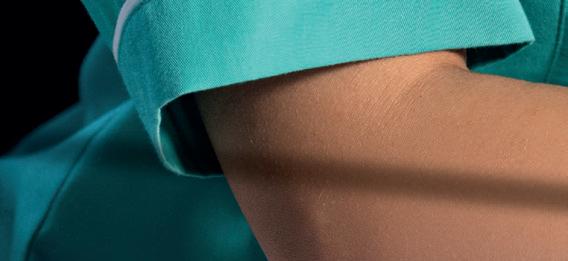

Stigma and addiction in liver disease

GIN cast THE GASTROINTESTINAL NURSING PODCAST
Join the discussion: www.magonlinelibrary.com/r/gincast Also available on Apple and Spotify

































































































































































































